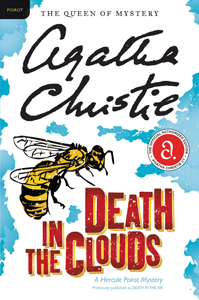Hercule Poirot is better known for solving murders on trains and riverboats, but he also solves a killing on an airplane (or “aeroplane,” by the terminology of the times) in “Death in the Clouds” (a.k.a. “Death in the Air,” 1935). He says there are two kinds of murders – those that he’s personally involved in, and those where he isn’t – and he tends to be more interested in the former category; such is this case of a money lender found dead in her seat on a France-to-England flight.
Sleuth among the suspects
It’s an old joke among fans of detective fiction that a suspicious number of murders happen around the sleuth, and here Agatha Christie underlines that issue as Poirot is technically among the dozen suspects who could’ve killed Madame Giselle with a poisoned dart. Indeed, the blowgun is found under Poirot’s seat. Inspector Japp and French detective Fournier laugh at the notion, but Poirot insists he should be considered out of fairness.
Although there’s little chance Poirot is the killer, Christie sets up a good collection of motives, means and opportunities for the other people in this “car” of the plane. “Clouds” is a fun brain puzzle; I like how Christie lists the items in each passenger’s luggage.

“Death in the Clouds” (1935)
Also published as: “Death in the Air”
Author: Agatha Christie
Genre: Mystery
Series: Hercule Poirot No. 11
Settings: France; Croydon, England; an airplane; 1934
Most of the novel takes place after the plane lands, and Poirot surprisingly forms an investigative team with two fellow passengers (who by definition are suspects) – lovebirds Jane Grey, a hairdresser, and Norman Gale, a dentist. We also get chapters about other passengers’ lives that suggest motives.
Good character piece
“Clouds” is a good character piece for Poirot, as he undertakes an unselfish act toward someone he just met that has nothing to do with the solving of the case. I always think of Poirot as a good man, despite his oversized self-confidence, and here is an example we can point to.
The author delivers entertaining meta commentary via the detective-fiction writer Mr. Clancy, who is a little too excited about having a real murder happen near him. This colorful character eats bananas and tosses peels in grates and argues that Sherlock Holmes is overrated.
Although “Clouds” is an engaging read, I feel like a plane is a poor location for a premeditated murder, as you’re automatically putting yourself on the police’s narrow suspect list. It seems a well-planned crime on the ground might be a better way to go. Christie continues to be enamored with the idea of costumed disguises here; I wonder if she is overstating their effectiveness. But her point that people don’t notice certain members of society is well taken.
High (flying) tech
The era’s technology, or lack thereof, plays a large role in “Clouds.” Poirot must find out if a passenger is secretly related to the victim, and it’s not a matter of accessing a database, as it would be today.

To my surprise, high technology factors into the solving of the case, as a photograph is sent over telephone lines. I’ve seen this done in movies as recent as the 1980s and was shocked to learn this could be done in the 1930s.
“Death in the Clouds” uses many formulaic elements – murders for money, lovers’ spats, and suspects adopting a disguise – and the solution (although fair enough) fell relatively flat for me. Too much happens off page (although not as much as in “The Boomerang Clue”). It’s a decent page-turning puzzler, though, and an unusually warm portrayal of Poirot.
Every week, Sleuthing Sunday reviews an Agatha Christie book or adaptation. Click here to visit our Agatha Christie Zone.

